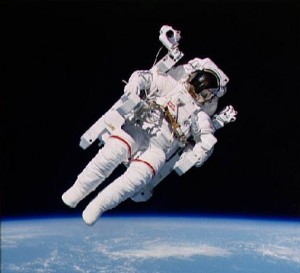Production is dead, long live reproduction.
Baudrillard
Just what kind of environmental suit does one need to survive in Baudrillard’s stark and parched “desert of the real”? In a world no longer enveloped by the imaginary production of natural relations or comforting similarities based upon our belief in a system of reference to an actual reality, Baudrillard suggests we are left in the blasted zone of the hyperreal: “the product of an irradiating synthesis of combinatory models in a hyperspace without atmosphere” (p. 167). Gasp!
In this vacuum, exposed to the fatal radiation of endless recombinatory excesses, certainty dissolves with the “liquidation of all referentials” (p. 167), and those who placed wagers that our skills in producing representation would secure the real within discursive and representational practices through art, politics and religion no longer have tokens with any value outside of the system itself. As such, no further bets can be taken using the collateral of real-estate. In any case, reference to the real is no longer the point.
“It is no longer a question of imitation, nor of reduplication, nor even of parody. It is rather a question of substituting signs of the real for the real itself; that is an operation to deter every real process by its operational double, a metastable, programmatic, perfect descriptive machine which provides all the signs of the real and short-circuits all its vicissitudes.” (p. 167)
Mimetically capacious machines deter any reference to the real, and it is sufficient for us to substitute a Main street model in Disneyland as a means of reaffirming, of feeding our belief in the values associated with such a mocked-up representation of the real.
For Augustine, “God is an intelligible sphere, whose centre is everyone, and whose circumference is nowhere” and within the atmosphere of this “intelligible sphere” Augustine and those who followed his philosophy had a referent that guaranteed all meanings. For Baudrillard, such a belief is possible in an economy of the sign that sees representation as a reflection of reality (and guaranteed by the presence of “Nature” of “God”). Such certainty is not to be found in the world of simulacrum where the model precedes the real, and where the real is produced not by reference to some mirror (or conceptual image), but from “miniaturized units, from matrices, memory banks and command models” (p. 167), from the code. Baudrillard inverts Augustine’s “intelligible sphere” so as to reproduce the atmosphere of the hyperreal:
What if God himself can be simulated, that is to say, reduced to the signs which attest his existence? Then the whole system becomes weightless; it is no longer anything but a gigantic simulacrum: not unreal, but a simulacrum, never again exchanging for what is real, but exchanging in itself, in an uninterrupted circuit without reference or circumference, and within this atmosphere” (p. 170).
Caught in this feedback loop, our critical tools are at risk as interpretation is endlessly recursive, unavoidably indeterminate, short-circuited by what Baudrillard the “precession of models” (p. 175). Attempts to critique power or to counter ideology have no purchase in the world of the hyperreal; worse such actions are merely part of the deterrence machine that Baudrillard sees as “set up in order to rejuvenate in reverse the fiction of the real” (p. 172).
One can only hope that there are sufficient reserves of oxygen and water in our environmental suits to allow us to survive in Baudrillard’s hyperreal.
